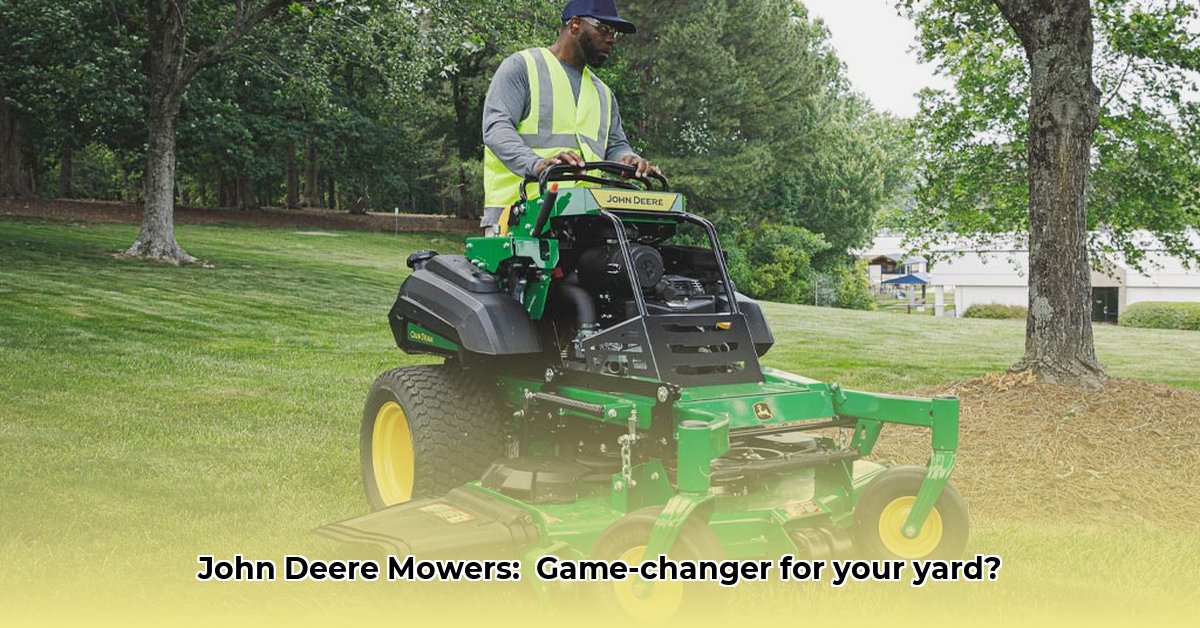
Choosing the right mowing equipment significantly impacts productivity and efficiency. John Deere offers two prominent lines: the Z540M for residential use and the commercial-grade ZTrak™ series for larger properties and professionals. For those needing PTO-powered options, check out tractor PTO mowers. This review compares these lines, examining performance, fuel efficiency, environmental considerations, and competitive landscape.
The Z540M: Residential Mowing Power
The Z540M boasts a 24-horsepower V-twin engine (a powerful engine with two cylinders arranged in a V-shape) featuring a durable cast-iron cylinder liner and overhead valves. This translates to both fuel efficiency and longevity. Its Accel Deep™ cutting deck minimizes overlapping cuts, saving fuel and time. User reviews praise its ease of operation and comfortable ride. However, its power might be insufficient for exceptionally large yards.
ZTrak™ Series: Commercial-Grade Efficiency
The ZTrak™ series caters to larger areas, offering speeds up to 20% faster than previous models—a significant time and fuel saver. Its ergonomic design reduces operator fatigue. While the initial investment is substantial, long-term savings in fuel and time often outweigh the cost, particularly for commercial use. Robust construction suggests a long service life, but increased maintenance compared to residential models needs consideration. John Deere financing options make these machines more accessible.
Environmental Impact: A Critical Assessment
While both lines prioritize efficiency, comprehensive data on their total environmental impact remains scarce. A critical gap exists in understanding the lifecycle assessment (LCA) of these mowers. This requires considering manufacturing processes, material sourcing, energy consumption during operation, and end-of-life disposal. A thorough LCA would quantify the greenhouse gas emissions, water usage, and waste generation associated with each stage of the mower's lifecycle. The absence of readily available data underscores the need for increased transparency from manufacturers and further independent research. Such studies would reveal opportunities for using sustainable materials and improving manufacturing methods. Furthermore, designing for easier recycling and component reuse in the end phase is crucial to minimizing environmental burden. The industry is increasingly recognizing and addressing the environmental concerns associated with manufacturing and disposal.
Comparing the Competition
John Deere faces competition offering electric or hybrid models with lower emissions but possibly less power and more limited runtimes, or simpler designs with lower maintenance requirements. A thorough comparison considering individual needs—property size, terrain, usage frequency—is crucial before making a purchase.
Choosing Your Mower: A Step-by-Step Guide
- Comprehensive Research: Compare fuel efficiency, running costs, features, and warranties across multiple brands.
- Needs Analysis: Evaluate property size, terrain, and mowing frequency to determine appropriate power and features.
- Budgeting: Account for the initial purchase, ongoing maintenance, and fuel expenses. Explore financing possibilities.
- Maintenance Planning: Regular maintenance is crucial for lifespan maximization and peak performance.
Risk Assessment Matrix
| Feature | Risk Level | Mitigation Strategies |
|---|---|---|
| Fuel Efficiency | Medium | Select appropriate engine size, use quality fuel, regular maintenance |
| Cutting Deck Durability | Medium | Careful operation, regular inspection and cleaning |
| Lifecycle Environmental Impact | High | Demand manufacturer LCAs, support sustainable practices |
| Repair Costs | Medium | Locate a reliable service provider, choose durable models |
| Obsolescence | Low | Prioritize long-term value and repairability |
The Regulatory Landscape
Emissions standards and waste disposal regulations are constantly evolving. Staying informed about such regulations is crucial for responsible mowing equipment ownership and operation. Manufacturers are adapting to stricter regulations through investment in more sustainable designs and manufacturing processes. This regulatory pressure is driving innovation within the industry.
Conclusion
John Deere provides impressive mowing solutions, but informed decisions involve multiple factors, including performance, cost, and environmental impact. Thorough research, careful needs assessment, and an awareness of current and future environmental regulations are paramount in selecting the ideal mowing equipment.